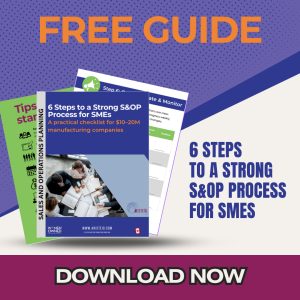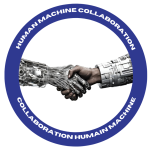
AI used to sound like a big-company luxury. Not anymore. For small and mid-sized businesses (SMBs), practical AI can plug directly into Sales & Operations Planning (S&OP) to improve forecasting, expose risks early, and align sales, operations, and finance—without a data science department or a seven-figure ERP upgrade.
From your podcast conversation with Dominic Blouin from Pawa , one theme stood out: S&OP is about a single, shared plan—and the consensus to back it. That consensus is hard, but it’s also the lever that turns AI insights into real decisions. To learn more about S&OP, read our earlier blog article Sales & Operations Planning: The Key to Scaling Manufacturing
Why S&OP + AI matters now (not later)
-
Agility is non-negotiable. Since COVID and repeated logistics shocks, monthly re-planning is essential, not optional. AI helps teams sense changes sooner and evaluate trade-offs faster.
-
Customer expectations are “Amazon-level.” Clients expect visibility and reliability; internally, teams expect the same information transparency they enjoy as consumers.
-
SMBs can compete with focus. You don’t need full enterprise stacks to benefit. Start where impact is highest and scale from there.
Two data points frame the opportunity: SMEs make up ~90% of businesses globally, underscoring why accessible S&OP and AI matter beyond large enterprises. (1)
Gartner research also indicates AI will be embedded in most new supply chain applications by 2026, and that decision-intelligence practices will be widely adopted—signals that practical AI for planning is becoming mainstream. (2)
What we learned from the podcast (and what to apply)
A plan unique et consensuel
S&OP is a monthly, cross-functional cadence that produces one consensus plan across sales, operations, and finance. The consensus is the hardest part—and the most strategic, because it forces trade-offs into the open and drives execution.
Agility beats firefighting
Organizations that rely only on weekly operational fixes get blindsided. The monthly S&OP cycle creates mid-range visibility (3–6 months), giving you time to adjust labor, capacity, and supplier commitments—before the crunch hits.
Finance is a core stakeholder
Finance isn’t an afterthought. In the executive S&OP meeting, finance participates to quantify the impact of decisions on revenue, margins, cash, and working capital—turning a plan into a viable business commitment.
“Amazonisation” sets the bar
Customers expect accurate ETAs and stable service levels. Internally, your teams expect integrated, timely data. S&OP + AI help you standardize calendars (e.g., promotions), align assumptions, and prevent surprises.
Don’t confuse forecasts, targets, and plans
-
Forecasts = best estimate of demand.
-
Targets = ambition (sales goals).
-
Plan = how supply/capacity will meet the forecast, not the target.
Blurring these creates friction and bad decisions. Keep them distinct in the process.
How AI actually helps S&OP (practical, not hype)
-
Demand forecasting: Machine learning models incorporate promotions, market signals, and downstream data (e.g., retail sell-out) to improve accuracy.
-
Variance analysis: Automated exception detection flags where the plan deviates from actuals, focusing meetings on what matters.
-
Decision intelligence: Natural-language summaries turn reports into actions for busy leaders.
-
Embedded adoption: Most gains come from augmenting the tools you already use, not replacing everything at once.
Gartner indicates that by 2026 over 80% of newly created supply chain applications will leverage AI and data science, and decision-intelligence practices will be mainstream—evidence that “practical AI” is where planning is headed. (2)
Best practices for implementing AI in S&OP (field-tested order)
1. Leadership involvement
Visible sponsorship sets expectations, allocates time/resources, and keeps the team focused on the single-plan discipline.
2. Communicate before, during, and after
Explain the “why,” share progress throughout the pilot, and publish the results after. Transparency builds trust and momentum.
3. Use a change-management approach
Treat adoption like a change project: identify stakeholders, anticipate resistance, design training, measure adoption—not just accuracy.
4. Start small—choose the right product category
Pilot on one family/segment with the most to gain. Prioritize:
- High-value or costly items
- Frequent stockouts/backorders
- Reliable enough data to demonstrate impact
This maximizes early wins and credibility.
5. Integrate with existing tools
Augment spreadsheets, BI dashboards, or ERP modules you already use; you don’t need a rip-and-replace to prove value.
6. Validate AI outputs with human expertise
Keep planners’ judgment in the loop. Challenge model recommendations; tune the model with real-world constraints.
7. Train the team
Make training practical: how to read forecasts, evaluate scenarios, and translate insights into supply, inventory, and service decisions.
8. Target one improvement at a time
Pick a focal KPI (forecast accuracy, service level, days of inventory, backorders). Stabilize gains before widening scope.
9. Iterate and scale
Run short cycles. Review, learn, adjust, expand. Build maturity step by step.
Challenges—and constructive ways to handle them
Cost concerns
-
What to do: Model scenarios comparing status quo vs incremental accuracy improvements (e.g., +3, +5, +7 points of forecast accuracy) and quantify the impact on stockouts, rush fees, and cash tied in inventory.
Data quality issues
-
What to do: Calculate the cost of bad data (errors, expediting, lost sales) versus the cost of incremental improvements and tooling. Many platforms help clean/normalize data over time, not just at the start.
Change resistance
-
What to do: Measure the hidden costs—time lost, morale, frustration, even health impacts—against the benefits of fewer fire drills and clearer priorities. Share early wins broadly.
Over-reliance on AI
-
What to do: Define ethical guardrails, invest in employee training, and build a community of practice so people keep learning together. Keep human judgment at the centre of S&OP.
Tooling overload
-
What to do: Avoid “Excel ping-pong” and manual file passing. Where possible, centralize data and automate recurring reports to protect the cadence.
Affordable AI options for SMB S&OP (augment what you have)
-
Microsoft Power BI (AI Insights) for scenario/variance analysis.
-
Excel / Google Sheets forecasting add-ins (low cost, fast to pilot).
-
Inventory & forecasting tools for SMBs (e.g., Pawa).
-
CRM/RevOps platforms with AI (e.g., HubSpot) to reconcile sales signals with demand planning.
Even small pilots can improve working capital, cut stockouts/overstocks, and free teams from manual number hunting.
Frequently asked questions
How can SMBs afford AI in S&OP?
Start with low-cost, subscription tools and limited pilots. Prove value on one KPI before expanding.
Do we need perfect data first?
No. Start with “good enough” and improve iteratively. Many tools help cleanse data as you go.
Can AI replace the S&OP process?
No. AI supports decision-making; S&OP remains a cross-functional discipline with leadership oversight.
Which KPIs should we track first?
Forecast accuracy, service level, backorders, inventory turns, cash-to-cash cycle. Pick one primary KPI for the pilot.
What’s a realistic first pilot?
One product family with frequent stockouts or high value, where data is stable enough to measure improvement within two S&OP cycles.
Sources (external)
(1) https://blogs.worldbank.org/en/psd/quest-better-understand-relationship-between-sme-finance-and-job-creation-insights-new-report?utm_source=chatgpt.com
(2) https://www.intersystems.com/sg/data-excellence-blog/faster-decision-making-time-to-insight-critical-for-increasing-supply-chain-resilience-improving-customer-experience/?utm_source=chatgpt.com
Conclusion & Call to Action
AI doesn’t have to be complex or costly to make S&OP better. With leadership sponsorship, a clear cadence, and a focused pilot on the right product family, SMBs can build agility, align decisions, and grow with confidence—without breaking the bank.
At Aristeío, we help organizations find the right balance between people, process, and technology. AI is just one lever, but combined with a solid S&OP process, it can transform the way your business operates.
Start your journey today:
– Download our Free S&OP Guide

– Try the Operational Maturity Assessment
Contact us to explore how AI-powered S&OP can fit your business.
About Veronica B. Marquez, M.Sc., CSSBB
 I help growing manufacturing and service organizations scale without chaos—by turning operational challenges into sustainable performance gains. My superpower is making strategy real at every level of the business: connecting people, processes, and purpose to drive productivity, engagement, and resilience. I bring clarity to complexity and help teams execute better, faster, together. Through a proven lens of operational excellence, continuous improvement, and supply chain optimization, I work with leaders to align efforts, simplify execution, and create systems that actually support growth.
I help growing manufacturing and service organizations scale without chaos—by turning operational challenges into sustainable performance gains. My superpower is making strategy real at every level of the business: connecting people, processes, and purpose to drive productivity, engagement, and resilience. I bring clarity to complexity and help teams execute better, faster, together. Through a proven lens of operational excellence, continuous improvement, and supply chain optimization, I work with leaders to align efforts, simplify execution, and create systems that actually support growth.
Named one of the Top 50 Experts in Operational Excellence by the PEX Network, I bring over 20 years of experience across sectors like manufacturing, distribution, mining, and public services. I teach Lean Six Sigma at the executive education level, lecture on service design in a master’s program, and host a LinkedIn Live series focused on Excellence in Industry 5.0.
Ready to explore how operational excellence can transform your business? Reach out https://www.linkedin.com/in/veronicabm/.
📷 Canva








